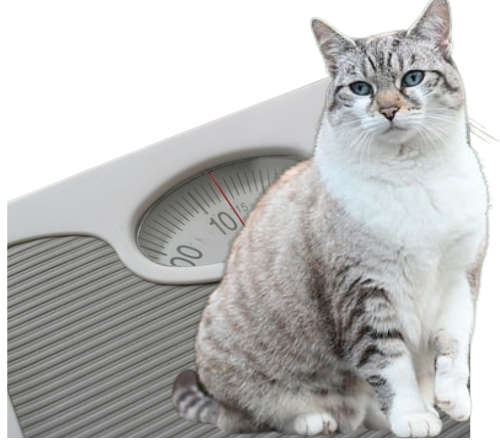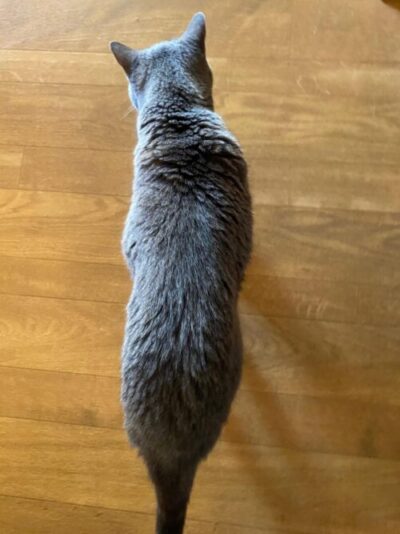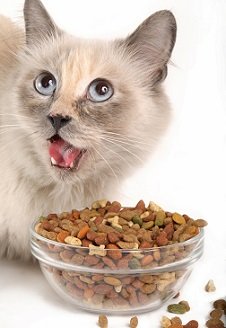
Is your cat looking a little… rounder than usual? You’re not alone! Many cats struggle with weight issues, but the good news is that with the right approach, you can help your feline friend slim down in a safe and stress-free way. Let’s dive into the best tips for helping your cat shed those extra pounds while keeping them healthy and happy!
Health Risks of Overweight Cats: What Owners Should Know
An overweight cat faces serious health risks that may not be immediately visible. These include: Decreased physical activity, reduced life expectancy, predisposition to joint disease, respiratory problems, cardiac diseases, circulatory problems, hepatic damage, reproductive system issues, metabolic conditions like diabetes, and cancer.
The health problems associated with being overweight often go unnoticed until it’s too late. You might observe your cat being less active or resting more than usual, but the underlying issues can remain hidden. That’s why it’s crucial to help your cat lose weight as soon as you spot signs of weight gain.
Starting a weight loss plan for your cat requires commitment and consistency. Your cat may beg for food, but staying firm with their diet will help them lose weight and improve their overall health. Follow these 7 steps to help your cat lose weight in a healthy, safe manner:
1. Assessing Your Cat’s Weight
Before making any changes to your cat’s routine, it’s important to know if they’re truly overweight. Here’s how you can assess their body condition and determine if it’s time to consider making adjustments for weight loss:
- Feel the ribs: You should be able to feel them under a thin layer of fat. If you have to press hard, your cat may need to lose a bit of weight.
- Look from above: A noticeable waistline is a sign of a healthy weight.
- Side view: A slight tummy tuck is ideal—if the belly sags, it’s time to adjust their diet.
If you’re unsure, it’s always a good idea to consult your vet for an assessment and personalized advice on getting your cat to a healthy weight.

2. Portion Control: The Key to Healthy Weight Loss
Portion control plays a crucial role in managing your cat’s weight. Many cats are unknowingly overfed. Here’s how you can manage their meals:
-
- Measure meals: Free-feeding can lead to overeating. Use a measuring cup or kitchen scale to give the right amount.
- Feed on a schedule: Providing two to three smaller meals a day can regulate metabolism and prevent overeating. Automatic cat food dispensers can help you feed your cat the right portion every day and adjusting the feeding portions and schedule according to your cat’s progress.
- Tailor portions to your cat: Instead of following strict feeding guidelines, adjust portions based on your cat’s progress and individual needs. Here’s how to do it:
2.1 How to Safely Calculate Weight Loss
According to Krista Seraydar, DMV, “Cats should not lose more than 1-2% of their total body weight per week.” So you need to aim for 1-2% of your cat’s body weight per week. For example, if your cat weighs 15 lbs (6.8 kg), the safe weight loss range would be 0.15–0.3 lbs (70–140g) per week. Decrease portions gradually to avoid drastic changes that could harm your cat.
2.2 Adjusting Your Cat’s Diet for Healthy Weight Loss
Start by cutting your cat’s food by 20%. After a week, weigh your cat. If they haven’t lost at least 1% of their weight, try reducing the food further or increasing their activity. If your cat loses more than 2% of their weight, keep the food the same for another week. If the weight loss is too fast, increase the food slightly while monitoring their activity.
3. Choosing the Right Food: Quality Over Quantity
When aiming to promote weight loss, the food you choose is essential. Not all cat foods are created equal! Keep these key points in mind when selecting healthy cat food:
- High-protein, low-carb diets: Cats are obligate carnivores and thrive on high-protein, low-carb options. Opt for grain-free healthy cat foods to avoid blood sugar spikes.
- Wet food over dry: Canned food provides better hydration and fewer carbs. However, basing a cat diet solely on wet food has its disadvantages, such as price and contamination risk. Cathy Meeks, Veterinary Specialist suggests that a mix of both diets, are the best approach for balanced nutrition.
- Limited Ingredient Diets (LID): If your cat has food sensitivities, LID can support healthy weight management.
- Prescription diets for weight loss: For more significant weight management needs, consult your vet for prescription diets tailored for weight loss.
When choosing between dry, wet, or raw food for your cat it’s best to work with your vet to determine the best diet for your cat’s unique needs and weight loss.

4. Get Moving: Fun Ways to Exercise Your Cat
One of the best ways to help your cat shed extra pounds is by encouraging them to be more active. Playing with your cat daily for at least 15 minutes straight will ensure your pet will spend his energy excess, especially if you have a single cat. If you’re thinking about how to get your cat moving more, try these fun methods:
- Interactive play: Use wand toys, laser pointers, or even motorized mice to get your cat moving.
- Puzzle feeders: Or keep your cat mentally and physically active as they “work” for their food. A budget-friendly option is the Slimcat toy ball food dispenser that makes your pet play, hunt and eat at the same time.
- Climbing spaces: Cat trees and window perches promote movement and exploration.
- Hunting games: Hide small food portions around the house to mimic natural hunting behavior.
- Leash training: Some cats enjoy supervised outdoor walks!
Bonus Tip: Even short, frequent play sessions can make a big difference!
My Cat Playing With an Interactive Toy:
5. Watch the Treats! Smart Snacking Tips
When it comes to promoting weight loss, treats can add up quickly. Instead of cutting them out completely, consider healthier options:
- Switching to lighter treats: Freeze-dried meats or small pieces of cooked chicken can be great choices.
- Using treats as rewards: Give them after exercise or playtime to reinforce positive habits.
- Breaking them into smaller pieces: This helps satisfy your cat without overdoing it on calories. Another option is getting any of the interactive Treat Toys designed for cats. You can place the smaller pieces of treats inside a toy, making your cat work for them.
6. Hydration: The Secret Weapon for Weight Loss
Hydration plays a big role in digestion and metabolism, so encouraging your cat to drink more water can support weight loss. Here’s how:
- Offering wet food: It’s hydrating and provides fewer carbs.
- Using a water fountain: Cats often prefer running water.
- Placing multiple water bowls: Keep water accessible around the house to encourage drinking.
7. Regular Vet Checkups: Tracking Progress
Losing weight should be gradual to be healthy. Regular vet visits are important for monitoring progress and ensuring that your cat is safely losing weight. Your vet can also rule out any underlying health issues that could affect your cat’s ability to lose weight.
Final Thoughts
Helping your cat lose weight doesn’t require drastic changes—it’s about creating healthier habits and sticking with them. With the right food, portion control, exercise, and a little patience, your cat will be on the path to a happier, healthier life. By understanding the best practices for weight loss, you’re setting them up for long-term success.
I don’t think you meant that a cat should eat 20 lbs of food a day!
Thank you Dan, you helped me to correct my typo.